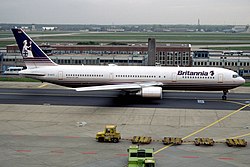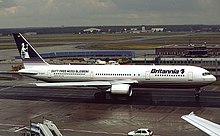Britannia Airways (Germany)
| Britannia Airways GmbH | |
|---|---|

|
|
| IATA code : | BN |
| ICAO code : | DBY |
| Call sign : | WINDSOR |
| Founding: | 1997 |
| Operation stopped: | 2001 |
| Seat: |
Waltersdorf , Germany |
| Operational bases: |
|
| Home airport : | Berlin Schönefeld Airport |
| Company form: | GmbH |
| Management: | |
| Number of employees: | 350 (2000) |
| Passenger volume: | 600,000 (1999) |
| Fleet size: | 3 |
| Aims: | international |
| Britannia Airways GmbH ceased operations in 2001. The information in italics refer to the last status before the end of operation. | |
The Britannia Airways GmbH (short and often for better differentiation of the British parent company Britannia GmbH ) was a German airline with seat in Waltersdorf . It was a subsidiary of the British Britannia Airways of the same name .
history
Even before founding its German subsidiary, the British Britannia Airways was aiming for flights from German airports to destinations in the Caribbean and the Dominican Republic in 1996. The same connections that were supposed to take place for the German tour operators CA Ferntouristik and Paul Günther Tours did not take place, however, because the Luftfahrt-Bundesamt prohibited the British company from operating the flights in October 1996 in order to protect the German market; it was stated that a British company was not allowed to serve third countries from Germany without a special permit. This is only possible in the event of capacity bottlenecks in the local companies. In view of the up to fifty percent lower flight prices and a possible migration of customers, German holiday airlines such as Condor and LTU had expressed their concerns. On the basis of this decision, the flight program actually envisaged was then converted by British Britannia Airways and provided with a stopover in Manchester. The latter measure made it possible to circumvent the restriction of the Luftfahrt-Bundesamt, but was faced with a lack of acceptance on the part of the passengers.
In the following year 1997, the actual German Britannia Airways was established as a subsidiary of the British parent company of the same name, in order to no longer have to be subject to the restrictions for foreign airlines. However, the Federal Aviation Office intervened again and refused the company's operating license , as the majority of the company's capital had to be in European ownership under current law. Although the British parent company was a European company, it itself belonged to the Thomson Travel Group, which was majority-owned by Canada. In order to be able to start operations nonetheless, 55 percent of the shares were transferred to European investors. Among them was not only the Munich bank Merck Finck & Co , but also the German Frosch Touristik International , FTI for short, which Britannia Airways served as a tourism cooperation partner and with whom a five-year contract had been concluded. The British parent company owned the remaining shares.
Flight operations began on November 1, 1997 with a Boeing 767 in the colors of the British parent company. With regard to the home airport, the decision was made in favor of Berlin-Schönefeld. The main field of activity of Britannia Airways was IT full charter flights , exclusively for FTI, which were carried out in the first winter season from Hamburg, Munich, Basel-Mulhouse and the base in Schönefeld to destinations in the Caribbean. Denser seating than usual at the time - 328 seats in contrast to the z. B. Condor's usual 269 seats on the Boeing 767 - enabled a price level that was around 20 to 30 percent below that of the German companies.
The LTU reacted to the developments by suing the FTI subsidiary CA Ferntouristik for omission: the former had advertised the newly founded Britannia Airways in their travel catalogs as “German airline” before the approval process was completed and flight operations began. CA Ferntouristik had to crush around 500,000 catalogs that had already been printed after a court decision on unfair competition . Regardless, Britannia Airways carried around 34,000 passengers during the first season. For the 1998 summer season, the program was expanded to include flights to Jamaica and Cuba on long-haul routes and flights to Mallorca and Malta on medium-haul routes. At the end of the year, 462,802 passengers were counted as a result and a second base was also set up in Munich, where another Boeing 767 was stationed.
FTI gave up its stake in Britannia Airways on October 30, 1998 in preparation for the establishment of its own airline, but nevertheless continued the cooperation. Towards the end of 1999 there were around 600,000 passengers with a fleet of three Boeing 767-300ERs and departures from numerous airports in Germany.
In April 2000, FTI negotiated a two-year contract extension with Britannia Airways. With the flyFTI, the former recently had its own company-owned airline, but it had only operated on medium-haul routes to date and had neither the appropriate long-haul aircraft nor an ETOPS certification. Despite the previous negotiations, the FTI surprisingly decided in the summer of the same year not to extend the contract with Britannia Airways; The background to this was the takeover of FTI Touristik by the Airtours group, also based in Great Britain and competing with the Britannia Airways parent company Thomson Travel. Although Britannia Airways, which had around 350 employees at the time, initially waived operational dismissals, it ceased operations in full on April 30, 2001 after the contract with the sole customer FTI had expired.
Destinations
Britannia Airways has served hot water destinations in the Caribbean and the Mediterranean from its bases in Schönfeld and Munich, other German airports and, in some cases, from Basel and Vienna as well.
fleet
The Britannia Airways fleet recently consisted of three machines:
| Aircraft type | number | Aircraft registration | Seats (Economy) |
annotation |
|---|---|---|---|---|
| Boeing 767-304ER | 3 | D-AGYC | 328 | leased from British Britannia Airways |
| D-AGYF | 326 | |||
| D-AGYH | 328 |
See also
Web links
Individual evidence
- ↑ a b c Ulrich Klee et al .: jp airline-fleets international 2000/01 . Bucher & Co., Glattbrugg 2000, ISBN 978-3-85758-134-2 , pp. 101 (English).
- ^ Tilmann Reuss (ed.): Yearbook of the aerospace industry . Südwestdeutsche Verlagsanstalt, Mannheim 2001, ISBN 3-87804-326-0 , p. 381 . (applies to both management positions)
- ↑ a b Andreas Spaeth: Dreaded Newbie. In: The time. Zeitverlag Gerd Bucerius, August 22, 1997, accessed on September 8, 2018 .
- ↑ Andreas Spaeth: Always cheaper than the Germans - How the holiday airline Britannia asserts itself against Condor and LTU. In: Hamburger Abendblatt. Hamburg newspaper group, January 27, 1999, accessed on September 8, 2018 .
- ↑ a b c Tom Gill: Rule Britannia? In: FlightGlobal. Reed Business Information, May 1, 1998, accessed September 8, 2018 .
- ^ A b c Karl-Dieter Seifert: The German air traffic 1955-2000, world traffic, liberalization, globalization (= Die deutsche Luftfahrt . No. 29 ). Bernard & Graefe, Bonn 2001, ISBN 3-7637-6121-7 , pp. 240 .
- ↑ a b c Klaus Vomhof: Leisure Airlines of Europe . Scoval, Newcastle-upon-Tyne 2001, ISBN 1-902236-09-2 , pp. 57 (English).
- ↑ Peter Hinze: Blue spots, blue bills. In: FOCUS magazine. September 8, 1997, accessed September 8, 2018 .
- ↑ Florian Kolf: The British send German vacationers on the trip. In: Der Tagesspiegel. Der Tagesspiegel publishing house, October 12, 1998, accessed on September 8, 2018 .
- ^ German operator to extend Britannia contract . In: Flight International . tape 157 , no. 4725 . Reed Business Information, April 18, 2000, ISSN 0015-3710 , p. 11 (English, flightglobal.com [accessed September 8, 2018]).
- ^ Britannia Airways: Airline in crisis. In: Der Tagesspiegel. Der Tagesspiegel publisher, 23 August 2000, accessed on 8 September 2018 .
